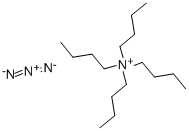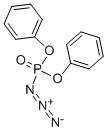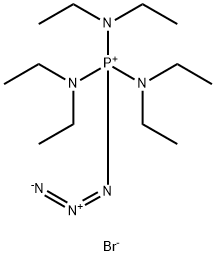Tributyltin azide
- CAS NO.:17846-68-3
- Empirical Formula: C12H27N3Sn
- Molecular Weight: 332.07
- MDL number: MFCD00216557
- SAFETY DATA SHEET (SDS)
- Update Date: 2025-02-18 19:55:12

What is Tributyltin azide?
Description
Tributyltin azide is a heterocyclic organic compound that is used in organic synthesis. It has shown antihypertensive activity and the ability to inhibit fatty acid synthesis. Tributyltin azide has also been shown to have biological properties, such as the coordination of proteins and enzymes.
The Uses of Tributyltin azide
Tributylstannanylium Azide is used in preparation method of Polycaprolactone-based Polyamide composite material.
Synthesis
A cooled solution of sodium azide (4.10 g, 63.0 mmol) in water (13 mt) at 8°C BusSnCI (17 1 ml) is added dropwise while stirring the solution. After 2h of stirring at 8°C, dichloromethane (38 mi) is added, stirred for another 5 minutes, and phases separated. The water phase is washed with dichloromethane (13 ml). Combined organic phases are washed with 10% NaCI (13 ml) and distilled water (13 ml). The organic phase is dried with sodium sulfate (6.34 g), and the solvent is removed under reduced pressure to give the oily product Tributyltin azide (19.2 g, 91.8%).
Properties of Tributyltin azide
| Boiling point: | 120°C/0.2mmHg |
| Density | 1.212 g/mL at 25 °C(lit.) |
| refractive index | 1.5745 |
| Flash point: | >230 °F |
| solubility | Miscible with toluene, hexane, acetonitrile and tetrahydrofuran. |
| Specific Gravity | 1.212 |
| Hydrolytic Sensitivity | 7: reacts slowly with moisture/water |
| InChI | InChI=1S/3C4H9.N3.Sn/c3*1-3-4-2;1-3-2;/h3*1,3-4H2,2H3;;/q;;;-1;+1 |
Safety information for Tributyltin azide
| Signal word | Danger |
| Pictogram(s) |
 Skull and Crossbones Acute Toxicity GHS06  Health Hazard GHS08  Environment GHS09 |
| GHS Hazard Statements |
H301:Acute toxicity,oral H312:Acute toxicity,dermal H315:Skin corrosion/irritation H319:Serious eye damage/eye irritation H372:Specific target organ toxicity, repeated exposure H410:Hazardous to the aquatic environment, long-term hazard |
| Precautionary Statement Codes |
P202:Do not handle until all safety precautions have been read and understood. P273:Avoid release to the environment. P280:Wear protective gloves/protective clothing/eye protection/face protection. P301+P310:IF SWALLOWED: Immediately call a POISON CENTER or doctor/physician. P305+P351+P338:IF IN EYES: Rinse cautiously with water for several minutes. Remove contact lenses, if present and easy to do. Continuerinsing. |
Computed Descriptors for Tributyltin azide
| InChIKey | JKVRTUCVPZTEQZ-UHFFFAOYSA-N |
| SMILES | [Sn](N=[N+]=[N-])(CCCC)(CCCC)CCCC |
New Products
Methyl (R)-1-Boc-4,4-difluoropyrrolidine-2-carboxylate 2,2-Difluoropropylamine hydrochloride tert-butyl 3-bromoazetidine-1-carboxylate (R)-1-Boc-3-hydroxypyrrolidine DIFLUOROACETIC ANHYDRIDE 2,2-Difluoropropionic acid Diallylamine, 99% Calcium hydroxide, 95% Aluminum oxide, basic 2-Bromophenylacetonitrile, 97% L-tert-Leucine,97% N-Hydroxy-2-methylpropanimidamide 4-(3,4-Dichlorophenyl)-3,4-Dihydro-N-Methyl-1-(2H)-Naphthalenimine (Schiff Base) 2-AMINO-3,5-DIBROMO BENZALDEHYDE [ADBA] L-Glutamic Acid Dimethyl Ester Hcl 10-Methoxy-5H-dibenz[b,f]azepine 5-Cyanophthalide N, N-Carbonyldiimidazole (CDI) Dibenzoyl Peroxide Titanium Dioxide 2-(Methylthio) Benzonitrile Sodium Acetate Anhydrous Allopurinol 1,5-DibromopentaneRelated products of tetrahydrofuran








You may like
-
 17846-68-3 Tributyl tin azide 98%View Details
17846-68-3 Tributyl tin azide 98%View Details
17846-68-3 -
![Cis-2-(Bromomethyl)-2-(2,4-Dichlorophenyl)-1,3-Dioxolane-4-Ylmethyl Benzoate [CBB] 61397-56-6 99%](https://img.chemicalbook.in//Content/image/CP5.jpg) Cis-2-(Bromomethyl)-2-(2,4-Dichlorophenyl)-1,3-Dioxolane-4-Ylmethyl Benzoate [CBB] 61397-56-6 99%View Details
Cis-2-(Bromomethyl)-2-(2,4-Dichlorophenyl)-1,3-Dioxolane-4-Ylmethyl Benzoate [CBB] 61397-56-6 99%View Details
61397-56-6 -
 287930-77-2 / 142569-70-8 99%View Details
287930-77-2 / 142569-70-8 99%View Details
287930-77-2 / 142569-70-8 -
 Ethyl-2-Chloroacetoacetate 609-15-4View Details
Ethyl-2-Chloroacetoacetate 609-15-4View Details
609-15-4 -
 CIS- BROMO BENZOATEView Details
CIS- BROMO BENZOATEView Details
61397-56-6 -
 609-15-4View Details
609-15-4View Details
609-15-4 -
![1-(6-Methylpyridin-3-Yl)-2-[4-(Methylsulfonyl)Phenyl]Ethanone [Ketosulfone] 99%](https://img.chemicalbook.in//Content/image/CP5.jpg) 1-(6-Methylpyridin-3-Yl)-2-[4-(Methylsulfonyl)Phenyl]Ethanone [Ketosulfone] 99%View Details
1-(6-Methylpyridin-3-Yl)-2-[4-(Methylsulfonyl)Phenyl]Ethanone [Ketosulfone] 99%View Details
221615-75-4 -
 27143-07-3View Details
27143-07-3View Details
27143-07-3
